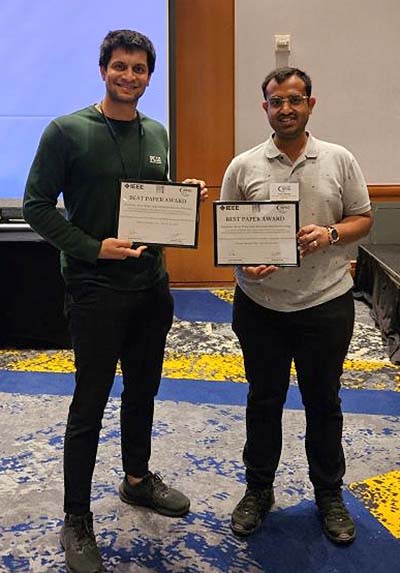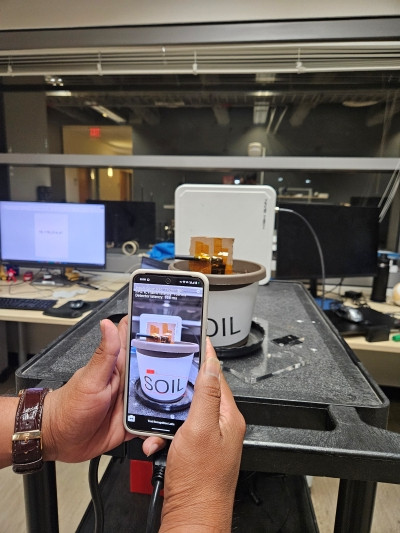Reimagining RFID: UC San Diego Researchers Develop Award-Winning Real-Time, Battery-Free Sensors
Named SenSync, the innovation transforms everyday RFID tags into real-time sensors, unlocking new applications in AR, robotics and sustainability.
Published Date
Story by:
Media contact:
Topics covered:
- Qualcomm Institute
- Electrical Engineering
- Center for Wireless Communications
- VR
- Jacobs School of Engineering
Share This:
Article Content
What if the same RFID “smart barcode” tags used to track packages and retail inventory could also detect changes in the real world—like temperature, pressure or weight—without batteries or added hardware?
That idea's now a reality, thanks to a team of researchers out of UC San Diego's Center for Wireless Communications (CWC) and Qualcomm Institute who have developed a robust and realtime RFID-based passive sensing system, i.e. a technique that can measure naturally occurring phenomena using harvested radio frequency (RF) energy. Ishan Bansal, a second-year master's student in computer engineering, and Dinesh Bharadia, an associate professor of electrical and computer engineering at the Jacobs School of Engineering, are spearheading the charge with a new paper.
Named SenSync, the software-based innovation recently earned the Best Paper Award at the 2025 IEEE RFID Conference, a top RFID-centric event for academics and industry alike. A travel grant from the National Science Foundation funded the team's attendance at the conference.

"Unlike a lot of conferences, IEEE RFID has a lot of industry involvement," explained Nagarjun Bhat, a co-author of the award-winning paper, "SenSync: Real-time and Accurate Passive Sensing," and a Ph.D. student in electrical engineering at the Jacobs School of Engineering. "This is a space where there's a lot of commercializable potential because companies take the ideas from here and use them to build a product that will reach thousands of people in the future."
Lead author Bansal explained that SenSync is a major leap forward for passive sensing, as it highlights how existing RFID infrastructure can be retooled to enable real-time, battery-free sensing. Low-cost RFID tags are already used in billions of products globally. While previous work from Bhat and CWC laid out how RFID tags can be used to sense data from a hardware standpoint, SenSync is what brings the image into focus.
When using a differential sensing system that involves two RFID ICs connected to the same antenna, it's possible for them to interfere with each other. Instead of sending their data to the reader simultaneously, Bansal noted the data would arrive sequentially. That can cause slight differences in the data streams, which makes it difficult to determine the correct values.
“My algorithm puts the two divergent sequences together and makes sense out of it,” said Bansal. “This enables us to sense clearly, repurposing RFID to get reliable sensor data without wires or batteries.”
Solving long-standing challenges in passive RFID sensing
RFID systems have traditionally been optimized for identification, not sensing—they're what's used to track packages or checked baggage. While other similar systems like Bluetooth exist, RFID devices are much more mature and widespread. About 50 billion RFID tags are sold every year, Bansal said, compared to four to five billion Bluetooth devices.
But despite their availability, implementing RFID systems isn’t always easy.
Commercial RFID readers are required to follow strict communications protocols that often include frequency hopping or sequential tag reading; in practice, this means that possibly distorted signals and timing mismatches have historically made sensing applications notoriously unreliable.
SenSync solves these problems using an algorithm called dynamic time warping (DTW), which was originally used in speech recognition.
So, how does it work? SenSync synchronizes—hence the name—data streams from multiple passive RFID tags and uses differential signal behaviors to get reliable readings.
“We don’t want to change the basic data," Bansal explained, "We just want to match it well.”
He noted that SenSync delivers five times greater sensory resolution and eight times the data throughput compared to previous passive RFID sensing methods, meaning it can process up to 500 data samples per second with sub-degree error rates, even in complex, dynamic environments.
“We were able to show that the data stream could be pushed every second without losing any accuracy or fidelity,” he added.
Real-world sensing, reimagined
That improved sensing capability opens up practical applications ranging from automating warehouses and monitoring agricultural plots to improving medical sensing and measuring food waste.
Already, Bansal, Bhat and the rest of their research team have highlighted how SenSync can work in an augmented reality (AR) environment and were also recognized at the SenSys 2025 conference (co-hosted by ACM and IEEE) for having the Best Demo - Runner-up.
"To empower our physical spaces with AI, you would need sensors and sensing. SenSync is truly an innovation that can provide that battery-free sensing and do so with extremely low power usage and no wires."

Using a smartphone-based AR app, conference attendees at IEEE RFID 2025 saw in real time how RFID tags could show the amount of force applied or visualize the moisture content in a pot of soil through AR.
Or, Bhat said, imagine a warehouse full of boxes upon boxes. You could just point your phone camera or AR glasses at a box and instantly see its weight without ever touching it, he explained.
"AR today is mostly limited to what your vision feed provides you," he noted. "But, the multimodal sensing enriches the data by pulling in the stimuli like temperature that we can't see. That's all done by the algorithm; without that, all the data you'd collect would be noisy and difficult to process in real time."
And, because SenSync is battery-free, runs on commercial RFID tags and requires no training data or recalibration, Bansal said that it offers a more sustainable, scalable sensing solution that can operate reliably in indoor, outdoor, or mobile environments.
“Our solution is actually truly ubiquitous,” he said, explaining that "you can drop it anywhere, and it’ll work the same way.”
From RFID to physical AI
Bhat, Bansal and Bharadia feel that SenSync could be more than just an upgrade to passive sensing—it could be the foundation of physical AI that links the real and virtual worlds.
"Large language models (LLMs) are powering AI around us," Bharadia explained, adding that most machine learning draws on text, voice or images, all of which are widely available and easily accessible. But other sensory information like temperature and humidity aren't yet available for someone to build an LLM. "To empower our physical spaces with AI, you would need sensors and sensing."
"SenSync is truly an innovation," he added, "that can provide that battery-free sensing and do so with extremely low power usage and no wires."
The paper, "SenSync: Real-Time and Accurate Passive Sensing," (doi: 10.1109/RFID64926.2025.11015540) was authored by Ishan Bansal, Nagarjun Bhat, Agrim Gupta, Harine Govindarajan and Dinesh Bharadia and published in IEEE XPlore.
Topics covered:
- Qualcomm Institute
- Electrical Engineering
- Center for Wireless Communications
- VR
- Jacobs School of Engineering
Share This:
You May Also Like
Engineers Take a Closer Look at How a Plant Virus Primes the Immune System to Fight Cancer
Technology & EngineeringStay in the Know
Keep up with all the latest from UC San Diego. Subscribe to the newsletter today.




